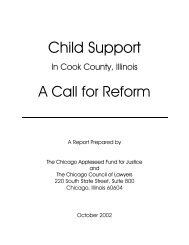Videoconferencing in Removal Hearings: A Case Study of the ...
Videoconferencing in Removal Hearings: A Case Study of the ...
Videoconferencing in Removal Hearings: A Case Study of the ...
You also want an ePaper? Increase the reach of your titles
YUMPU automatically turns print PDFs into web optimized ePapers that Google loves.
Table 4.2: Use <strong>of</strong> Interpreter and Frequency <strong>of</strong> Problems 60<br />
Hear<strong>in</strong>gs with no<br />
<strong>in</strong>terpreter<br />
(% <strong>of</strong> row total)<br />
Hear<strong>in</strong>gs with<br />
<strong>in</strong>terpreter<br />
(% <strong>of</strong> row total)<br />
Total<br />
(% <strong>of</strong> row total)<br />
Problems<br />
Occurred<br />
26<br />
(33.8%)<br />
23<br />
(69.7%)<br />
49<br />
(44.5%)<br />
No Problems<br />
Occurred<br />
42<br />
51<br />
(66.2%)<br />
10<br />
(30.3%)<br />
61<br />
(55.5%)<br />
Total<br />
77<br />
(100%)<br />
33<br />
(100%)<br />
110<br />
(100%)<br />
Immigrants who used <strong>in</strong>terpreters were statistically more likely to have<br />
difficulties with videoconferenc<strong>in</strong>g. As shown above, 70% experienced problems, while<br />
only 33% <strong>of</strong> immigrants without <strong>in</strong>terpreters had any trouble. The higher frequency <strong>of</strong><br />
problems was largely due to a higher rate <strong>of</strong> <strong>in</strong>terpretation difficulties, but <strong>in</strong>terpreter-<br />
dependent immigrants also tended to experience more technical problems, access to<br />
counsel issues, and testimonial and evidentiary problems than immigrants who did not<br />
use <strong>in</strong>terpreters. Immigrants who depended on <strong>in</strong>terpreters had a statistically higher rate<br />
<strong>of</strong> experienc<strong>in</strong>g evidentiary-testimonial complications, such as not hav<strong>in</strong>g access to<br />
charg<strong>in</strong>g documents.<br />
An immigrant who relied on an <strong>in</strong>terpreter had a statistically higher chance <strong>of</strong><br />
removal as well. Almost one-half <strong>of</strong> those us<strong>in</strong>g <strong>in</strong>terpreters received removal orders<br />
dur<strong>in</strong>g <strong>the</strong>ir videoconference hear<strong>in</strong>g, as opposed to 23% for English-speak<strong>in</strong>g<br />
immigrants. 61 This is a difficult trend to unravel – we did not have enough data to make<br />
60<br />
Cited problems <strong>in</strong>cluded technical failures, access to counsel, <strong>the</strong> presentation <strong>of</strong> evidence, and<br />
<strong>in</strong>terpretation.<br />
61 18 (or 23.4%) out <strong>of</strong> 77 English-speak<strong>in</strong>g immigrants received removal orders, while 16 (or 48.5%) <strong>of</strong><br />
33 non-English speakers received removal orders.




